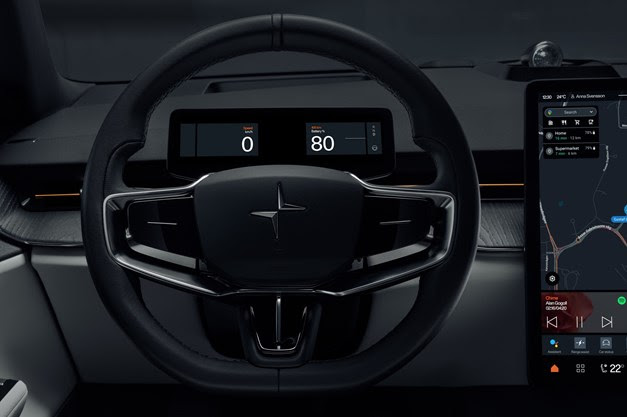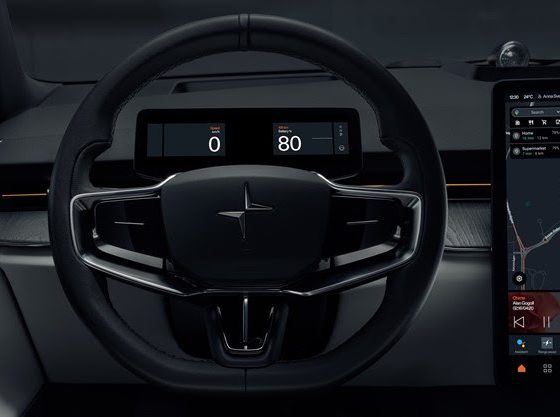Polestar plans to demonstrate its Smart Eye driver monitoring technology in January at the Consumer Electronics Show (CES) in Las Vegas.
Polestar’s Smart Eye technology is designed using two closed-loop premium driver monitoring cameras that track head, eye, and eyelid movements and trigger warning sounds or messages, or even go as far as bringing the car to a stop if the system detects a distracted, drowsy, or disconnected driver. Smart Eye, in conjunction with other standard Driver Assistance features like Lane Keeping, Adaptive Cruise Control, and more, helps to keep drivers safe.
Smart Eye and @PolestarCars will demonstrate the Polestar 3 #DMS, designed to help avoid accidents and save lives, at CES 2023 in Las Vegas!
The Polestar 3 will be on display in Smart Eye’s booth (#6353) in the West Hall. See you there!
Read more: https://t.co/9bNW1xJl17 pic.twitter.com/i4Hqa2fBjO
— Smart Eye (@SmartEyeAB) December 15, 2022
Polestar plans to display to visitors how the Smart Eye system utilizes AI software to detect driver attentiveness in real time and how it tracks head and eye movements to determine if an operator is paying attention and engaged in driving behaviors.
“This technology addresses some of the main reasons behind fatal accidents and can help save lives by prompting the driver to refocus attention on the road – and can initiate preventive action when they don’t, or can’t,” Thomas Ingenlath, Polestar’s CEO, said.
The development of driver monitoring systems has helped decrease instances of distracted driving. The technology is advantageous in multiple applications, especially as semi-autonomous driving systems and more advanced ADAS systems have come to the market.
In vehicles not equipped with semi-autonomous driving functionality, driver monitoring systems can help keep drivers’ eyes on the road and off of things like cell phones, which are a leading cause of distracted driving accidents in the United States. The NHTSA said 3,142 people were killed due to distracted driving in 2020.
The systems are also hugely effective in cars that feature semi-autonomous driving. Although these systems allow drivers to relinquish certain responsibilities like speed control or lane keeping, they are not fully autonomous and still require the operator’s attention. Unfortunately, some drivers take advantage of these features and use them irresponsibly, which is where systems like Smart Eye will come in.
Polestar is not the first and will certainly not be the last automaker to employ these systems to keep drivers safe. Tesla activated cabin-facing cameras to monitor driver behavior in mid-2020. General Motors has driver monitoring systems for its Super Cruise system. Ford also has driver monitoring for its BlueCruise. Lucid has driver monitoring as a primary focus of its DreamDrive suite. It’s only a matter of time before more automakers adopt camera or AI-based driver monitoring systems.
Ford Blue Cruise and GM Super Cruise lauded in Consumer Reports’ driver monitoring rankings
Generally, driver monitoring systems help keep drivers safe. They are more effective than things like steering wheel sensors as they can be cheated with various methods, including vehicle-specific cheat devices. Educating drivers on how the systems work and how they keep operators accountable is essential. Polestar’s demonstration will likely lead to a better understanding of how technology and AI can lead to safer roads.
I’d love to hear from you! If you have any comments, concerns, or questions, please email me at joey@teslarati.com. You can also reach me on Twitter @KlenderJoey, or if you have news tips, you can email us at tips@teslarati.com.

News
Tesla FSD fleet is nearing 7 billion total miles, including 2.5 billion city miles
As can be seen on Tesla’s official FSD webpage, vehicles equipped with the system have now navigated over 6.99 billion miles.

Tesla’s Full Self-Driving (Supervised) fleet is closing in on almost 7 billion total miles driven, as per data posted by the company on its official FSD webpage.
These figures hint at the massive scale of data fueling Tesla’s rapid FSD improvements, which have been quite notable as of late.
FSD mileage milestones
As can be seen on Tesla’s official FSD webpage, vehicles equipped with the system have now navigated over 6.99 billion miles. Tesla owner and avid FSD tester Whole Mars Catalog also shared a screenshot indicating that from the nearly 7 billion miles traveled by the FSD fleet, more than 2.5 billion miles were driven inside cities.
City miles are particularly valuable for complex urban scenarios like unprotected turns, pedestrian interactions, and traffic lights. This is also the difference-maker for FSD, as only complex solutions, such as Waymo’s self-driving taxis, operate similarly on inner-city streets. And even then, incidents such as the San Francisco blackouts have proven challenging for sensor-rich vehicles like Waymos.
Tesla’s data edge
Tesla has a number of advantages in the autonomous vehicle sector, one of which is the size of its fleet and the number of vehicles training FSD on real-world roads. Tesla’s nearly 7 billion FSD miles then allow the company to roll out updates that make its vehicles behave like they are being driven by experienced drivers, even if they are operating on their own.
So notable are Tesla’s improvements to FSD that NVIDIA Director of Robotics Jim Fan, after experiencing FSD v14, noted that the system is the first AI that passes what he described as a “Physical Turing Test.”
“Despite knowing exactly how robot learning works, I still find it magical watching the steering wheel turn by itself. First it feels surreal, next it becomes routine. Then, like the smartphone, taking it away actively hurts. This is how humanity gets rewired and glued to god-like technologies,” Fan wrote in a post on X.
News
Tesla starts showing how FSD will change lives in Europe
Local officials tested the system on narrow country roads and were impressed by FSD’s smooth, human-like driving, with some calling the service a game-changer for everyday life in areas that are far from urban centers.

Tesla has launched Europe’s first public shuttle service using Full Self-Driving (Supervised) in the rural Eifelkreis Bitburg-Prüm region of Germany, demonstrating how the technology can restore independence and mobility for people who struggle with limited transport options.
Local officials tested the system on narrow country roads and were impressed by FSD’s smooth, human-like driving, with some calling the service a game-changer for everyday life in areas that are far from urban centers.
Officials see real impact on rural residents
Arzfeld Mayor Johannes Kuhl and District Administrator Andreas Kruppert personally tested the Tesla shuttle service. This allowed them to see just how well FSD navigated winding lanes and rural roads confidently. Kruppert said, “Autonomous driving sounds like science fiction to many, but we simply see here that it works totally well in rural regions too.” Kuhl, for his part, also noted that FSD “feels like a very experienced driver.”
The pilot complements the area’s “Citizen Bus” program, which provides on-demand rides for elderly residents who can no longer drive themselves. Tesla Europe shared a video of a demonstration of the service, highlighting how FSD gives people their freedom back, even in places where public transport is not as prevalent.
What the Ministry for Economic Affairs and Transport says
Rhineland-Palatinate’s Minister Daniela Schmitt supported the project, praising the collaboration that made this “first of its kind in Europe” possible. As per the ministry, the rural rollout for the service shows FSD’s potential beyond major cities, and it delivers tangible benefits like grocery runs, doctor visits, and social connections for isolated residents.
“Reliable and flexible mobility is especially vital in rural areas. With the launch of a shuttle service using self-driving vehicles (FSD supervised) by Tesla in the Eifelkreis Bitburg-Prüm, an innovative pilot project is now getting underway that complements local community bus services. It is the first project of its kind in Europe.
“The result is a real gain for rural mobility: greater accessibility, more flexibility and tangible benefits for everyday life. A strong signal for innovation, cooperation and future-oriented mobility beyond urban centers,” the ministry wrote in a LinkedIn post.
News
Tesla China quietly posts Robotaxi-related job listing
Tesla China is currently seeking a Low Voltage Electrical Engineer to work on circuit board design for the company’s autonomous vehicles.

Tesla has posted a new job listing in Shanghai explicitly tied to its Robotaxi program, fueling speculation that the company is preparing to launch its dedicated autonomous ride-hailing service in China.
As noted in the listing, Tesla China is currently seeking a Low Voltage Electrical Engineer to work on circuit board design for the company’s autonomous vehicles.
Robotaxi-specific role
The listing, which was shared on social media platform X by industry watcher @tslaming, suggested that Tesla China is looking to fill the role urgently. The job listing itself specifically mentions that the person hired for the role will be working on the Low Voltage Hardware team, which would design the circuit boards that would serve as the nervous system of the Robotaxi.
Key tasks for the role, as indicated in the job listing, include collaboration with PCB layout, firmware, mechanical, program management, and validation teams, among other responsibilities. The role is based in Shanghai.
China Robotaxi launch
China represents a massive potential market for robotaxis, with its dense urban centers and supportive policies in select cities. Tesla has limited permission to roll out FSD in the country, though despite this, its vehicles have been hailed as among the best in the market when it comes to autonomous features. So far, at least, it appears that China supports Tesla’s FSD and Robotaxi rollout.
This was hinted at in November, when Tesla brought the Cybercab to the 8th China International Import Expo (CIIE) in Shanghai, marking the first time that the autonomous two-seater was brought to the Asia-Pacific region. The vehicle, despite not having a release date in China, received a significant amount of interest among the event’s attendees.










